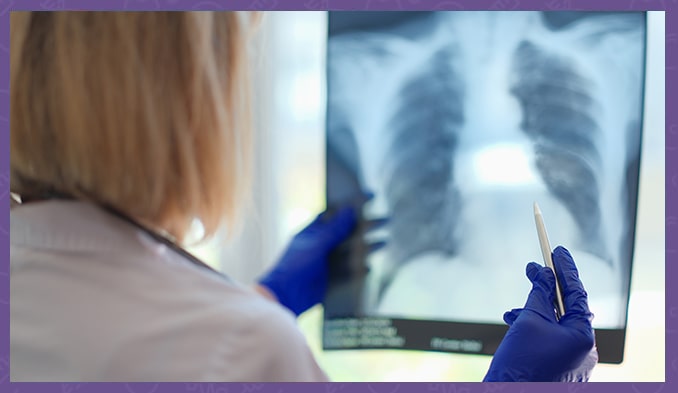-
What is the disease pulmonary hypertension?
Pulmonary hypertension (PH), also known as pulmonary hypertension, is an uncommon but extremely serious condition. In this disease, the pressure in the circulation of the lungs remains elevated for an extended period of time. Pulmonary hypertension can be detected in different clinical cases and is divided into a total of five groups depending on its physiological and pathological characteristics. This condition in most cases begins its development due to difficulties in the cardiac and pulmonary function of the patient. One of the main causes is the impaired function of the left ventricle of the heart, known as left ventricular dysfunction, which belongs to the second group. The third group includes parenchymal lung disease with hypoxia. In about 60% of cases of patients with serious problems in left ventricular function of the heart, they subsequently develop pulmonary hypertension.
In cases of COPD (chronic obstructive pulmonary disease), there is a significant risk of PH. The incidence is about 20% of cases, with an increase in risk of over 50% in advanced disease. In contrast, the likelihood of developing PH in the other three groups (1, 4 and 5) is significantly lower. An example of group 4 is chronic thromboembolic pulmonary hypertension, which can occur after acute pulmonary embolism and affects about 5 in 1 million people annually.
-
Does pulmonary hypertension affect high blood pressure in the patient?
PH is a reflection of pulmonary vasculature resistance when it is higher than usual. However, systemic hypertension is not considered the only possible cause of the development of pulmonary hypertension. In some patients, the possibility exists that arterial hypertension may lead to the development of hypertensive disease in the left side of the heart. Diastolic dysfunction is also possible, which in some cases lead to pulmonary hypertension.
-
What is the increased tension in the lungs due to and for which groups of people can it pose a danger?
Pulmonary hypertension is divided into five groups that reflect the different causes of the disease. In patients with advanced lung disease, serious heart failure, and diastolic dysfunction, it is advisable to have regular prophylactic examinations to detect PH. In cases where the patient has comorbidities such as:
- HIV infection
- portal hypertension
- connective tissue diseases
- haemolytic anaemia
- congenital heart anomalies
- or previous experience with the intake of toxins and drugs, there is a serious risk of developing pulmonary hypertension.
-
What are the main symptoms of this disease?
Pulmonary hypertension in most cases progresses without pronounced clinical symptoms until it reaches a more advanced stage of its development. One of the most common symptoms is shortness of breath on exercise. Other symptoms of this disease include feeling weak, chest pain, and fatigue. When PH is in a more progressive stage, a state of dizziness, swelling of the limbs, hemoptysis, brief loss of consciousness (syncope), weakness without loss of consciousness (presyncope) are observed. These symptoms may occur both on physical exertion and in a resting state. One of the challenges in making a diagnosis of pulmonary hypertension is that any of these symptoms can be caused by a variety of other diseases. Diagnosis is therefore often delayed until symptoms become severe and extensive damage to the vascular system becomes apparent.
-
How are patients with this disease correctly diagnosed?
When considering cases of pulmonary hypertension, various conditions such as angina and/or a gradual decrease in the ability to exercise, syncope and dyspnoea should always be taken into account. Frequent extensive diagnostic procedures are required, such as:
- chest X-rays
- functional tests for lung assessment
- transthoracic echocardiography
- lung scan (ventilation/perfusion),
- high-resolution computed tomography of the chest, including ECG.
Echocardiography is used as the primary screening method to assess the likelihood of pulmonary hypertension by measuring the arterial pressure in the lungs. However, an accurate diagnosis of PH is established by performing an invasive hemodynamic measurement with a special catheter inserted into the patient's right heart. When the patient is diagnosed, further diagnostic investigations are also performed to establish the exact cause of the development of PH.
-
What are the methods of treatment of the disease?
It is extremely important for the patient that the appropriate treatment is determined according to the specific cause of the development of PC. This highlights the need for a precise diagnosis and orientation as to which of the five groups PH falls into. Therefore, patients with this disease should be referred to specialist centres of expertise for treatment. Patients falling into group 1 of pulmonary hypertension undergo specialized vasodilator therapy. For the remaining patients in groups 2, 3 and 5, treatment directed at the underlying pulmonary and cardiac disease is prescribed. Chronic thromboembolic pulmonary hypertension belonging to group 4 requires surgical treatment by pulmonary endarterectomy. Percutaneous balloon pulmonary angioplasty is a minimally invasive method aimed at improving blood circulation in the lungs by dilating narrowed or occluded pulmonary arteries. In order to achieve the best hemodynamic results, staged procedures with dilatations and catheterizations are often performed.
-
What are the possible complications?
Low morbidity (1.1%) and mortality rates (0.055%) were reported when right hemithoracic catheterization used to diagnose pulmonary hypertension was performed. The procedure is performed in specialized medical centers. Some complications may occur when this type of manipulation is performed. Problems such as bruising of the skin at the catheter insertion site, air embolism, cardiac tamponade, pulmonary artery rupture, significant bleeding due to vein injury, or arrhythmia.






